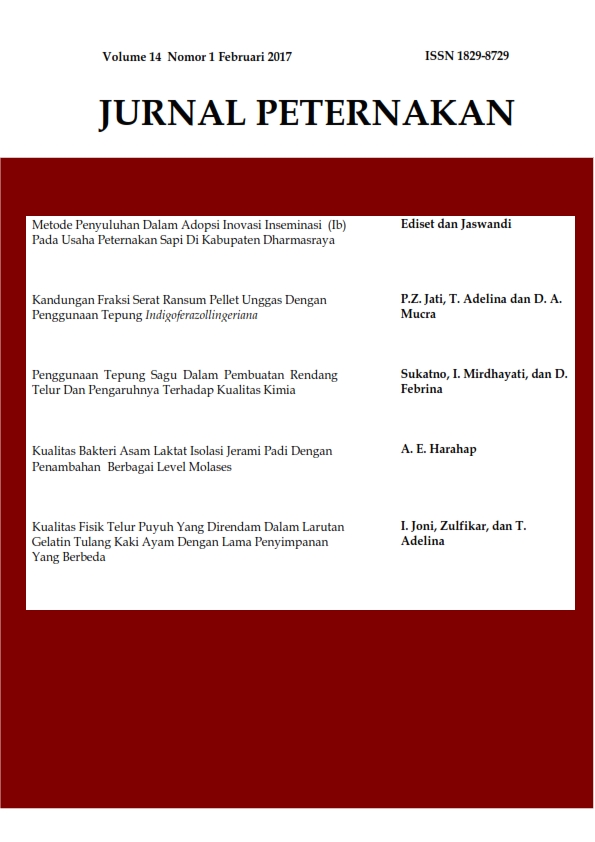Penggunaan Tepung Sagu Dalam Pembuatan Rendang Telur Dan Pengaruhnya Terhadap Kualitas Kimia
DOI:
https://doi.org/10.24014/jupet.v14i1.3397Keywords:
Rendang telur, sago flour, chemical propertiesAbstract
Rendang telur is one of the Indonesian local foods that were popular in west Sumatra community. Rendang telur is presented in combination egg crackers and dried rendang seasoning. Generally, the main ingredient used in making egg crackers was combination of rice flour and wheat flour. This research was conducted to study the using of sago flour as a main ingredient due to sago had high availability in Riau province and utilization of non rice starch. The aims of this research was to know the chemical properties of Rendang telur that were made by using sago flour. The experimental design was Complete Randomize Design with four treatments and four replications.The treatments were amount of sago flour that were used, consists of A (rice flour 25 g as a control), B (sago flour 25 g), C (sago flour 30 g) and D (sago flour 35 g). Variable analyzed were protein content, moisture content, lipid content, acid value and content of free fatty acid. The result show that the protein content ranged between
9.14-6.42% wb, the moisture content ranged between 2.94-2.04%, fat content ranged between 41.01-30.6% wb, acid value and
free fatty acid ranged between 1.70-2.14 mg and 1.09-1.37%, respectively. It can be concluded that sago flour could use as
replacer rice flour if amount added is not more than 30 g based on protein content. An addition of 35 g sago flour could reduce protein content, but non significance effect to moisture content, fat content, acid value and free fatty acid content.
References
Astawan, M. 1999. Rendang dan Kalio.
Departeman Teknologi Pangan dan Gizi.
Institut Pertanian Bogor. Bogor.
Badan Standar Nasional Indonesia. 1996 Standar Nasional Indonesia: 4307. Standar Olahan Kerupuk Beras. Dewan Standar Nasional. Jakarta.
Fadila, I. 2011. Potensi Sagu dalam Upaya Diversifikasi Pangan. Universitas Terbuka. Tangerang Selatan.
Kam, N. O. 1992. Daftar Analisis Bahan Makanan. Fakultas Kedokteran Universitas Indonesia. Jakarta, 53p.
Kataren, S. 1986. Pengantar Teknologi Minyak dan
Lemak Pangan. UI Press, Jakarta.
Laiya, N., R. M. Harmain., N. Yusuf. 2014.
Formulasi Kerupuk Ikan Gabus (Chana striata) yang Disubstitusi dengan Tepung Sagu. Artikel Ilmiah. Fakultas Ilmu Pertanian Universitas Negri Gorontalo. Gorontalo.
Lestari, S. M. 2015. Karakterisasi Fisikokimia Kerupuk Melinjo sebagai Upaya Diversifikasi Produk Olahan Melinjo. Pros Sem Nas Masy Biodiv Indon. 1(1):131-135.
Nugra, A E. 2011. Kadar Protein dan Mutu Organoleptik Rendang Telur Itik dengan Level Telur Itik yang Berbeda. Skripsi. Fakultas Pertanian dan Peternakan Universitas Islam Negri Sultan Syarif Kasim Riau. Pekanbaru.
Nurwanto. 2012. Sifat Organoleptik Rendang Kelinci dan Rendang Sapi. Skripsi. Fakultas Pertanian dan Peternakan Universitas Islam Negri Sultan Syarif Kasim Riau. Pekanbaru.
Rahmadana. 2013. Analisa Masa Simpan Rendang Ikan Tuna dalam Kemasan Vakum Selama Penyimpanan pada Suhu Ruang dan Dingin. Skripsi. Fakultas Pertanian Universitas Hasanuddin. Makassar.
Septiva, D. R. 2013. Pengaruh Jumlah Daging Belut (Monopterus albus) dan Penambahan Puree Wortel (Daucus carota) pada Hasil Jadi Kerupuk. e-journal Boga, 2(3):95-103.
Singhal, R. S., J. F. Kennedy., S. M.
Gopalakrishnan., A. Kaczmareck., C. J. Knill. P. F. Akmar. 2008. Industrial Production, Processing, and Utilization of Sago Palm- Derived Products. Charbohydrate Polimers,
:1-20.
Sudaryani. 2003. Kandungan gizi telur.
Universitas Sumatra Utara. Medan.
Wahyuningtyas, N., Basito., dan W. Atmaka.
Kajian Karakteristik Fisikokimia dan
Sensoris Kerupuk Berbahan Baku Tepung Terigu, Tepung Tapioka dan Tepung Pisang Kepok Kuning. Jurnal Teknosains Pangan,
(2):76-85.
Downloads
Published
Issue
Section
License
The Authors submitting a manuscript do so on the understanding that if accepted for publication, copyright of the article shall be assigned to Jurnal Peternakan and published by Fakultas Pertanian dan Peternakan Universitas Islam Negeri Sultan Syarif Kasim Riau as publisher of the journal.
Authors who publish with this journal agree to the following terms:
Authors automatically transfer the copyright to the journal and grant the journal right of first publication with the work simultaneously licensed under a Creative Commons (CC BY) that allows others to share the work with an acknowledgement of the work's authorship and initial publication in this journal.
Authors are able to enter into separate permission for non-exclusive distribution of the journal's published version of the work (e.g., post it to an institutional repository or publish it in a book), with an acknowledgement of its initial publication in this journal.
Authors are permitted and encouraged to post their work online (e.g., in institutional repositories or on their website) prior to and during the submission process, as it can lead to productive exchanges, as well as earlier and greater citation of published work (See The Effect of Open Access).

